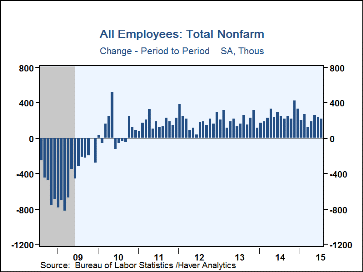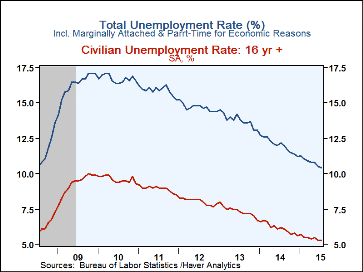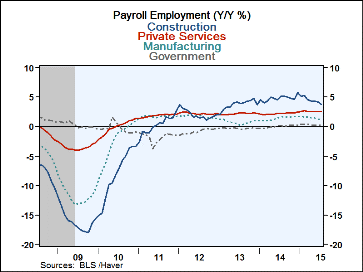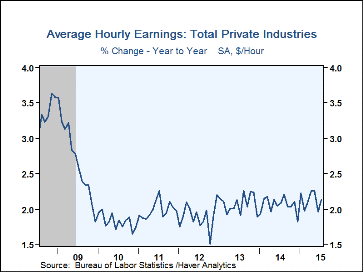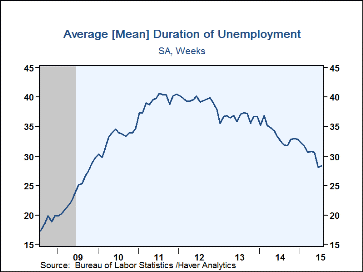 Global| Aug 07 2015
Global| Aug 07 2015U.S. Payroll Employment Gain Eases; Jobless Rate Holds Steady
by:Tom Moeller
|in:Economy in Brief
Summary
Nonfarm payroll employment during July increased 215,000 (2.1% y/y) following upwardly revised increases of 231,000 and 260,000 in June and May. The latest increase fell a little short of expectations for 221,000 in the Action [...]
Nonfarm payroll employment during July increased 215,000 (2.1% y/y) following upwardly revised increases of 231,000 and 260,000 in June and May. The latest increase fell a little short of expectations for 221,000 in the Action Economics Forecast Survey. Improvement in services employment continued to lead the increase in jobs. The unemployment rate held steady at 5.3%, as expected. The overall unemployment rate, including marginally attached and those working part-time for economic reasons, eased m/m to 10.4%, down from 12.2% one year ago. Average hourly earnings matched expectations with a 0.2% rise (2.1% y/y).
From the payroll employment survey, the 215,000 jobs rise was the weakest in three months. The three-month average gain of 235,000 was, however, the firmest rise since February. Factory sector employment improved 15,000 (1.2% y/y), the strongest gain in six months. Construction employment, however, improved just 6,000, well off December's pace of 44,000. Mining jobs were reduced by 4,900 (-7.9% y/y), the seventh straight month of decline. Private service sector jobs rose 193,000 (2.6% y/y). Professional & business services employment gained a lessened 40,000 (3.6% y/y) but temporary help jobs declined 8,900 (4.5% y/y), the first decline since February. Education & health services jobs improved 37,000 (2.8% y/y), the weakest rise this year. Retail employment grew 35,900 (2.0% y/y), on a par with the prior three months. Leisure & hospitality jobs advanced 30,000 (3.0% y/y) after a 24,000 increase while employment in financial activities improved 17,000 (2.0% y/y). Wholesale sector employment rose 6,300 (1.4% y/y). Employment in the public sector continued weak with a 5,000 rise (0.4% y/y). Local government employment increased 8,000 (0.3% y/y) and jobs in the federal sector were unchanged (0.6% y/y). State government employment fell 3,000 (+0.5% y/y).
The average workweek notched up to 34.6 hours after holding at 34.5 hours last quarter. The latest level matched the highest point since all of 2007. As a result, aggregate hours worked strengthened 0.5% (2.7% y/y), the most for any month since November 2013.
Average hourly earnings in the private sector improved 0.2%. That left the three-month change at 0.1%, on a par with the weakest growth of the economic expansion. Slower growth has been prevalent across industry sectors.
From the household employment survey, the unemployment rate of 5.3% left it at the lowest level since April 2008. It reflected a 101,000 rise (1.7% y/y) in employment and a 69,000 increase (0.7% y/y) in the labor force. The labor force participation rate of 62.6% was down from its high of 67.1%, averaged from 1997 to 2000. The number of eligible workers not in the labor force grew 2.0% y/y.
The average teenage unemployment rate eased sharply to 16.2%, its lowest point since April 2008. For adult men it averaged 4.8%, a 7-year low, and for adult women it ticked up to 4.9%, also near the 7-year low. The average duration of unemployment ticked up to 28.3 weeks, but still well off the 2012 high of 39.4 weeks.
The unemployment rate amongst individuals with less than a high school diploma averaged 8.3% while for high school graduates with no college, it was 5.5%. For those without a college degree, the mean unemployment rate was 4.4% and for those with a bachelors degree or higher, it was 2.6%.
The labor market data is contained Haver's USECON database. Detailed figures are in the EMPL and LABOR databases. The expectations figure is in the AS1REPNA database.
| Employment: (SA M/M Change, 000s) | Jul | Jun | May | Y/Y | 2014 | 2013 | 2012 |
|---|---|---|---|---|---|---|---|
| Payroll Employment | 215 | 231 | 260 | 2.1% | 1.9% | 1.7% | 1.7% |
| Previous | -- | 223 | 254 | -- | -- | -- | -- |
| Manufacturing | 15 | 2 | 6 | 1.2 | 1.4 | 0.8 | 1.7 |
| Construction | 6 | 0 | 12 | 3.5 | 4.8 | 3.7 | 2.1 |
| Private Service Producing | 193 | 220 | 254 | 2.6 | 2.2 | 2.2 | 2.2 |
| Government | 5 | 4 | 8 | 0.4 | 0.0 | -0.3 | -0.8 |
| Average Weekly Hours - Private Sector | 34.6 | 34.5 | 34.5 | 34.5 (Jul.'14) |
34.5 | 34.5 | 34.4 |
| Private Sector Average Hourly Earnings (%) | 0.2 | -0.0 | 0.2 | 2.1 | 2.1 | 2.1 | 1.9 |
| Unemployment Rate (%) | 5.3 | 5.3 | 5.5 | 6.2s (Jul.'14) |
6.1 | 7.4 | 8.1 |
Tom Moeller
AuthorMore in Author Profile »Prior to joining Haver Analytics in 2000, Mr. Moeller worked as the Economist at Chancellor Capital Management from 1985 to 1999. There, he developed comprehensive economic forecasts and interpreted economic data for equity and fixed income portfolio managers. Also at Chancellor, Mr. Moeller worked as an equity analyst and was responsible for researching and rating companies in the economically sensitive automobile and housing industries for investment in Chancellor’s equity portfolio. Prior to joining Chancellor, Mr. Moeller was an Economist at Citibank from 1979 to 1984. He also analyzed pricing behavior in the metals industry for the Council on Wage and Price Stability in Washington, D.C. In 1999, Mr. Moeller received the award for most accurate forecast from the Forecasters' Club of New York. From 1990 to 1992 he was President of the New York Association for Business Economists. Mr. Moeller earned an M.B.A. in Finance from Fordham University, where he graduated in 1987. He holds a Bachelor of Arts in Economics from George Washington University.


